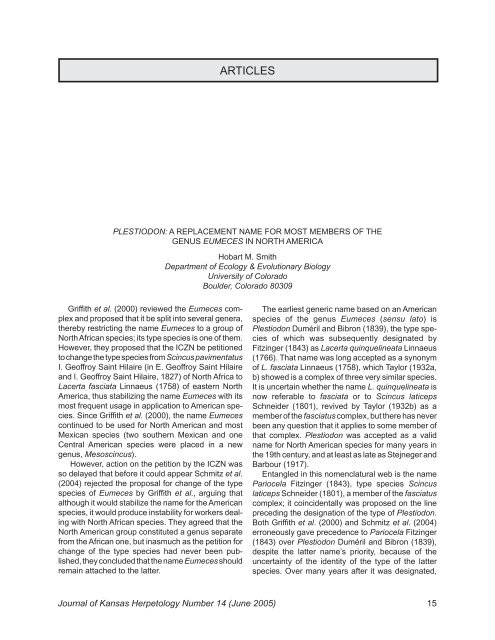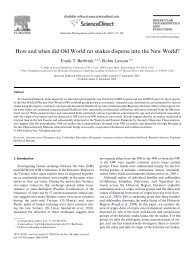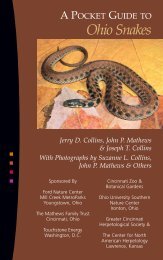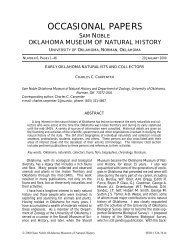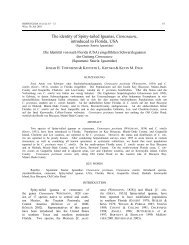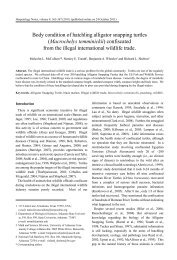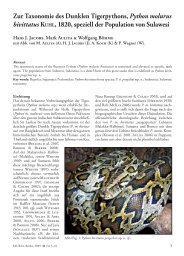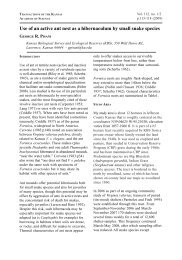Plestiodon - The Center for North American Herpetology
Plestiodon - The Center for North American Herpetology
Plestiodon - The Center for North American Herpetology
Create successful ePaper yourself
Turn your PDF publications into a flip-book with our unique Google optimized e-Paper software.
Griffith et al. (2000) reviewed the Eumeces complex<br />
and proposed that it be split into several genera,<br />
thereby restricting the name Eumeces to a group of<br />
<strong>North</strong> African species; its type species is one of them.<br />
However, they proposed that the ICZN be petitioned<br />
to change the type species from Scincus pavimentatus<br />
I. Geoffroy Saint Hilaire (in E. Geoffroy Saint Hilaire<br />
and I. Geoffroy Saint Hilaire, 1827) of <strong>North</strong> Africa to<br />
Lacerta fasciata Linnaeus (1758) of eastern <strong>North</strong><br />
America, thus stabilizing the name Eumeces with its<br />
most frequent usage in application to <strong>American</strong> species.<br />
Since Griffith et al. (2000), the name Eumeces<br />
continued to be used <strong>for</strong> <strong>North</strong> <strong>American</strong> and most<br />
Mexican species (two southern Mexican and one<br />
Central <strong>American</strong> species were placed in a new<br />
genus, Mesoscincus).<br />
However, action on the petition by the ICZN was<br />
so delayed that be<strong>for</strong>e it could appear Schmitz et al.<br />
(2004) rejected the proposal <strong>for</strong> change of the type<br />
species of Eumeces by Griffith et al., arguing that<br />
although it would stabilize the name <strong>for</strong> the <strong>American</strong><br />
species, it would produce instability <strong>for</strong> workers dealing<br />
with <strong>North</strong> African species. <strong>The</strong>y agreed that the<br />
<strong>North</strong> <strong>American</strong> group constituted a genus separate<br />
from the African one, but inasmuch as the petition <strong>for</strong><br />
change of the type species had never been published,<br />
they concluded that the name Eumeces should<br />
remain attached to the latter.<br />
ARTICLES<br />
PLESTIODON: A REPLACEMENT NAME FOR MOST MEMBERS OF THE<br />
GENUS EUMECES IN NORTH AMERICA<br />
Hobart M. Smith<br />
Department of Ecology & Evolutionary Biology<br />
University of Colorado<br />
Boulder, Colorado 80309<br />
<strong>The</strong> earliest generic name based on an <strong>American</strong><br />
species of the genus Eumeces (sensu lato) is<br />
<strong>Plestiodon</strong> Duméril and Bibron (1839), the type species<br />
of which was subsequently designated by<br />
Fitzinger (1843) as Lacerta quinquelineata Linnaeus<br />
(1766). That name was long accepted as a synonym<br />
of L. fasciata Linnaeus (1758), which Taylor (1932a,<br />
b) showed is a complex of three very similar species.<br />
It is uncertain whether the name L. quinquelineata is<br />
now referable to fasciata or to Scincus laticeps<br />
Schneider (1801), revived by Taylor (1932b) as a<br />
member of the fasciatus complex, but there has never<br />
been any question that it applies to some member of<br />
that complex. <strong>Plestiodon</strong> was accepted as a valid<br />
name <strong>for</strong> <strong>North</strong> <strong>American</strong> species <strong>for</strong> many years in<br />
the 19th century, and at least as late as Stejneger and<br />
Barbour (1917).<br />
Entangled in this nomenclatural web is the name<br />
Pariocela Fitzinger (1843), type species Scincus<br />
laticeps Schneider (1801), a member of the fasciatus<br />
complex; it coincidentally was proposed on the line<br />
preceding the designation of the type of <strong>Plestiodon</strong>.<br />
Both Griffith et al. (2000) and Schmitz et al. (2004)<br />
erroneously gave precedence to Pariocela Fitzinger<br />
(1843) over <strong>Plestiodon</strong> Duméril and Bibron (1839),<br />
despite the latter name’s priority, because of the<br />
uncertainty of the identity of the type of the latter<br />
species. Over many years after it was designated,<br />
Journal of Kansas <strong>Herpetology</strong> Number 14 (June 2005) 15
however, its identity was in no doubt whatever; that<br />
the species was later discovered to be a complex of<br />
species, none of which are referable to any other<br />
genus, does not affect its status as a generic type (see<br />
Article 75.5 of the Code, International Commission on<br />
Zoological Nomenclature, 1999). Furthermore,<br />
Pariocela has never, except in the indicated works,<br />
been accepted as valid, whereas <strong>Plestiodon</strong> has a<br />
long history of acceptance.<br />
For these reasons we recommend adoption of the<br />
name <strong>Plestiodon</strong> <strong>for</strong> those <strong>American</strong> species <strong>for</strong>merly<br />
referred to Eumeces, except <strong>for</strong> those now placed in<br />
Mesoscincus.<br />
Literature Cited<br />
Geoffroy Saint Hilaire, E. and I. Geoffroy Saint Hilaire.<br />
1827. Description des reptiles qui se trouvent en<br />
Égypt. Pp. 115-160, in Description de l’Égypt, ou<br />
recueil des observations et des recherches qui ont<br />
été faites en Égypte pendant l’expédition de l’Armée<br />
Français. Histoire Naturelle. Tome premier. Paris,<br />
Imprimerie Impériale.<br />
❄<br />
Griffith, H, A. Ngo and R. W. Murphy. 2000. A cladistic<br />
evaluation of the cosmopolitan genus Eumeces<br />
Wiegmann (Reptilia, Squamata, Scincidae). Russian<br />
Journal of <strong>Herpetology</strong> 7: 1–16.<br />
International Commission on Zoological Nomenclature.<br />
1999. International Code of Zoological Nomenclature.<br />
International Trust <strong>for</strong> Zoological Nomenclature,<br />
London. 306 pp.<br />
Schmitz, A., P. Mausfeld and D. Embert. 2004. Molecular<br />
studies on the genus Eumeces Wiegmann,<br />
1834: phylogenetic relationships and taxonomic<br />
implications. Hamadryad 28: 73–89.<br />
Schneider, J. G. 1799–1801. Historiae amphibiorum<br />
naturalis et literariae. Jena, Frommann. 2 Vols.<br />
Stejneger, L. and T. Barbour. 1917. A Check List of<br />
<strong>North</strong> <strong>American</strong> Amphibians and Reptiles. Harvard<br />
University Press, Cambridge. iv + 125 pp.<br />
Taylor, E. H. 1932a. Eumeces inexpectatus: A new<br />
<strong>American</strong> lizard of the family Scincidae. University<br />
of Kansas Science Bulletin 20: 251–258.<br />
Taylor, E. H. 1932b. Eumeces laticeps: A neglected<br />
species of skink. University of Kansas Science<br />
Bulletin 20: 263–272.<br />
Journal of Kansas <strong>Herpetology</strong> Number 14 (June 2005) 16


